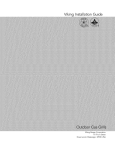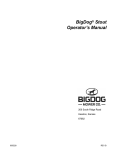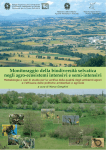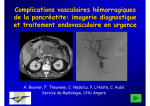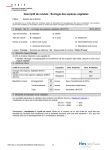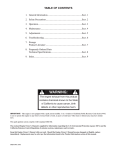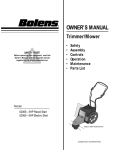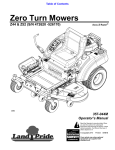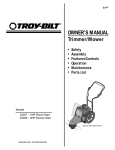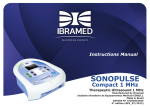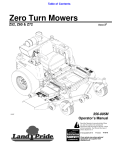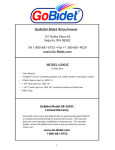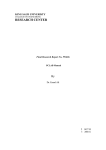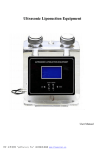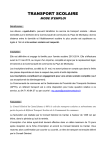Download Guidelines for Pollutant Export Modelling
Transcript
Guidelines for Pollutant Export Modelling in Brisbane Version 7 - Draft (Supplement to BCC Water Quality Management Guidelines) October 2003 Stormwater quality improvement devices: an artificial wetland, a trash rack and a grassed swale BCC would like to acknowledge the following individuals for their contribution to the Guidelines for Pollutant Export Modelling in Brisbane Version 7- Draft: Tim Fletcher Graham Jenkins Malcolm Eadie Matt Francey Dale Brown CRC-Catchment Hydrology School of Environmental Engineering, Griffith University Ecological Engineering Pty Ltd Melbourne Water Melbourne Water Guidelines for Pollutant Export Modelling in Brisbane Version 7 – Draft Revision 2 i Table of Contents 1.0 INTRODUCTION 1 2.0 MUSIC 4 2.1 2.2 2.3 2.4 2.5 2.6 2.7 MUSIC Simulation Process Meteorological Data Source Nodes 2.3.1 Area 2.3.2 Soil Properties 2.3.3 Pollutant Concentration Drainage Links Treatment Devices 2.5.1 Vegetated Swales 2.5.2 Bioretention Systems 2.5.3 Buffer Strips 2.5.4 Constructed Wetlands 2.5.5 Ponds 2.5.6 Gross Pollutant Traps 2.5.7 Sediment Basins 2.5.8 Generic Treatment Node Other Modelling Scenarios 2.6.1 Instream Works 2.6.2 Losses from the System 2.6.3 Rainwater Tanks Requirements for Development Applications for MUSIC 3.0 AQUALM 3.1 3.2 3.3 AQUALM model parameters 3.1.1 Rainfall-runoff Model 3.1.2 Pollutant Export 3.1.3 Annual Pollutant Loads Other Pollutant Loads 3.2.1 Point Loads 3.2.2 Septic Loads Analysis of Treatment Options 5 6 8 10 11 13 15 17 19 21 23 24 26 28 29 31 32 32 32 32 33 35 35 35 38 40 41 41 41 42 4.0 GLOSSARY 43 5.0 ABBREVIATIONS 44 6.0 BIBLIOGRAPHY 45 7.0 INDEX 47 Guidelines for Pollutant Export Modelling in Brisbane Version 7 – Draft Revision 2 ii 1.0 Introduction These guidelines are intended to assist developers and consulting engineers to establish input parameters specific to Brisbane for use in two common stormwater quality modelling programs: the Model for Urban Stormwater Improvement Conceptualisation (MUSIC) and AQUALM-XP. The guidelines also detail the modelling data that are recommended for inclusion in development applications. These guidelines will be used by Brisbane City Council (BCC) officers when they assess development applications relating to runoff water quality and stormwater treatment devices. BCC has prepared these guidelines as a supplement to, rather than a substitute for, its Water Quality Management Guidelines (BCC 2000a) and the MUSIC/ AQUALM-XP users’ manuals (CRC-CH 2002; WP Software 1992) and supersedes the Guidelines for Pollutant Export Modelling in Brisbane Version 6. Figure 1.1 shows where this document sits in the framework for water quality management under Brisbane City Council’s planning scheme. Why undertake water quality modelling? Council requires water quality modelling to be completed for some development activities (BCC 2000a). Such modelling predicts the likely water quality emanating from a catchment and the performance of specific stormwater treatment measures. This evaluation can be compared with performance targets such as water quality objectives (WQOs), enabling stormwater managers to minimise the impacts on receiving waters of changes in land use and management. WQOs are measurable long-term goals for the quality of receiving waters. The median annual pollutant concentrations (from combined wet and dry weather flows) generated by a development during its operational phase must meet the WQOs. For further information on WQOs and their application, please consult the Guidelines on Identifying and Applying Water Quality Objectives in Brisbane City (BCC 2000b), the Water Quality Management Guidelines (BCC 2000a) and the relevant codes and policies in Brisbane City Plan 2000 (BCC 2000c), hereafter referred to as City Plan. Chapter 13 of the Draft Australian Runoff Quality (ARQ) (IEAust 2003) also provides further information on the philosophies of modelling of urban stormwater management systems. Who should undertake water quality modelling? The Water Quality Management Guidelines (BCC 2000a) define the process for determining whether water quality modelling is needed for a subdivision and development application. If required, the modelling must be undertaken by a qualified specialist with demonstrated experience in modelling water quality or expertise in the processes upon which the model is based. It is strongly encouraged that all submissions to BCC relating to water quality modelling be accompanied by a letter of certification or endorsement from either a Guidelines for Pollutant Export Modelling in Brisbane Version 7 – Draft Revision 2 1 Registered Professional Engineer of Queensland (RPEQ) or similar professional with recognised industry certification. Figure 1.1:The Framework for Water Quality Management Under Brisbane City Council’s Planning Scheme National Water Water Quality Quality National Management Strategy Integrated Planning Act 1997 Environmental Protection Act 1994 Environmental Protection (Water) Policy 1997 BCC Corporate Plan BCC Urban Stormwater Management Strategy v.2 (under review) BCC City Plan Waterways Code Planning Scheme Policy (Management of Urban Stormwater Quality) Acid Sulfate Soil Code Stormwater Management Code ‘High level’ BCC policy Detailed policy in the City Plan Primary water quality management guidelines BCC Guideline: ‘Guideline on Identifying and Applying WQOs in Brisbane City’ (2000) BCC Guidelines: ‘Design Guidelines for SQIDs’ (1999) BCC Guidelines: ‘Guidelines for Pollutant Export Modelling in Brisbane City’ (2003) Version 7 ‘Best Practice Guidelines for the Control of Stormwater Pollution from Residential Building Sites’ (2003) Guidelines for Pollutant Export Modelling in Brisbane Version 7 – Draft Revision 2 State legislation Planning Scheme Policy (Acid Sulfate Soils) BCC Subdivision and Development Guidelines Part C ‘Water Quality Management Guidelines’ ‘Erosion and Sediment Control (ESC) Standard’ (Version 8, BCC 2000) – relevant to large sites National water quality management policy Secondary, technical water quality management guidelines 2 What models are catered for by the guidelines? Input parameters have been produced for the two most frequently used models in Brisbane: MUSIC and AQUALM-XP. If methods or models other than MUSIC or AQUALM-XP are used to assess the performance of stormwater management measures (e.g. XP-SWMM), practitioners need to demonstrate: • the suitability of the model • that the results meet the WQOs. What is the basis for the guidelines? For approximately ten years BCC has been monitoring the quality of urban stormwater in Brisbane (BCC 1999a, 2000d, 2001a, 2002a, 2003a). The research has been used to develop input parameters for water quality modelling in Brisbane. Specifically, pollutant concentrations and their export relationship with certain land uses have been derived. These data are augmented by five years’ research into the efficiency of several Stormwater Quality Improvement Devices (SQIDs) including vegetated swales, wetlands and gross pollutant traps (GPTs) (BCC 2000e, 2001b, 2002b, 2003b). A number of other monitoring programs are also being conducted in South East Queensland. Agencies currently involved in monitoring include Ipswich City Council, Gold Coast City Council and the Environmental Protection Agency. Please contact these agencies for further information on their monitoring programs. Guidelines for Pollutant Export Modelling in Brisbane Version 7 – Draft Revision 2 3 2.0 MUSIC MUSIC is a decision support tool for stormwater managers (CRCCH 2002). It helps them to plan and design (to conceptual level) appropriate urban stormwater management systems for catchments. MUSIC has been developed by the Cooperative Research Centre for Catchment Hydrology (CRC-CH) and was released in May 2002. MUSIC estimates stormwater pollution generation and simulates the performance of a group of stormwater management measures configured in series or parallel to form a ‘treatment train’. By simulating the performance of stormwater quality improvement measures MUSIC determines if a proposed system can meet WQOs. A users’ manual has been developed by the CRC-CH. Technical support and information on training sessions can be found on the CRC website: http://www.catchment.crc.org.au/ It is proposed that MUSIC will be updated once a year for the next four years, to allow for inclusion of the outcomes of new science. These updates to MUSIC may have a significant impact on current modelling approaches and hence these guidelines will be updated periodically to reflect this. Users of these guidelines are advised to confirm they are using the most up-to-date version by contacting the Brisbane City Council, Urban Management Division’s Water Resources Branch via the Brisbane City Council Call Centre on 07 3403 8888. Practitioners’ Notes • MUSIC does not currently incorporate all aspects of stormwater management that decision-makers must consider. Hydraulic analysis of stormwater drainage, life cycle cost analysis, indicators of ecosystem health and the integration of urban stormwater management facilities into the urban landscape are currently omitted from the model. • MUSIC is not a detailed design tool; it does not contain the algorithms necessary for detailed sizing of structural stormwater quantity and/ or quality facilities. Guidelines for Pollutant Export Modelling in Brisbane Version 7 – Draft Revision 2 4 WQOs Not Achieved Run MUSIC Simulation Review METROLOGICAL DATA Section 2.2 Select PREFERRED OPTIONS Section 2.5 Consider/Review ALL TREATMENT OPTIONS Section 2.5 Insert DRAINAGE LINKS Section 2.4 Input AREA DATA Section 2.3.1 Define Source Nodes Section 2.3 WQOs Achieved Compare RESULTS WITH WQOs Section 1.0 Input TREATEMNT DEVICE DESIGN AND PERFORMANCE Select LINK ROUTING Section 2.4 Select POLLUTANT CONC. DATA Section 2.3.3 Select SOIL PROPERTIES Section 2.3.2 Select RAINFALL DARA SET & TIME STEP Section 2.2 Select METEOROLOGICAL DATA Section 2.2 Guidelines for Pollutant Export Modelling in Brisbane Version 7 – Draft Revision 2 WQOs Achieved Compare RESULTS WITH WQOs Section 1.0 Run MUSIC Simulation Open MUSIC The following diagram is provided as a guide to users undertaking a MUSIC simulation. 2.1 MUSIC Simulation Process WQOs Not Achieved Prepare DEVELOPMENT APPLICATION Section 2.7 Conceptual design Conceptual design parameter ranges Performance Characteristics No routing Translation only Muskingum-Cunge Pollutant concentrations Estimation method Serial auto correlation Common soil properties Deep and shallow soils, impervious area Groundwater Catchment area Effective impervious area percentage 1980-1990 Rainfall period Time of concentration Detention time of treatment nodes 5 2.2 Meteorological Data The first step in creating a MUSIC model is to select appropriate rainfall data and time steps. Meteorological data files contain recorded rainfall depths per time step over a nominated period. MUSIC requires the user to select the meteorological data set (period and time step) that will be used as the basis for the runoff generation algorithms. MUSIC version 1.0 has rainfall records for Brisbane covering the period between 1950 and 2000. Recommended References CRC-CH 2002 Model for Urban Stormwater Improvement Conceptualisation User Manual Version 1.00. DPI et al. 1992 Queensland Urban Drainage Manual Meteorological Template File Rainfall Data Set A rainfall period of 10 years, specifically 1980-1990, should be used for all modelling for development assessment applications. This period was selected as it: • is a long enough duration to allow the rainfall-runoff model to reach equilibrium, in terms of soil stores, without a ‘warm up period’ having significant influence on the overall simulation results • is sufficiently long enough duration to simulate a reasonable range of climatic conditions • provides a balance between modelling accuracy and simulation time and output file size • represents a 10 year duration with a mean annual rainfall closest to the median value of all the data. Time Step The selection of an appropriate time step is a balance between reasonable accuracy and computational time. Smaller time steps will reduce routing errors through small nodes but will also result in longer computational times and larger results files. As a simple ‘rule of thumb’ the MUSIC User Manual (CRC-CH 2002) suggests the time step should not be greater than the ‘time of concentration’ of the smallest Source Node (and preferably three to four times smaller). However, the time step should also be selected based upon the smallest detention time of any Treatment Nodes. When setting up your MUSIC catchment file you may not know what (if any) treatment style you will be analysing so an iterative approach may be required. Determining the time of concentration of your smallest source node may be done using techniques outlined in the Queensland Urban Drainage Manual (DPI et al. 1992). Alternatively, Figure 2.1 provides a graphical summary of typical time steps (times of concentrations) which may be expected for differing catchment sizes and average catchment slopes. Guidelines for Pollutant Export Modelling in Brisbane Version 7 – Draft Revision 2 6 Figure 2.1: Recommended Rainfall Data Time Steps Practitioners’ Notes • The MUSIC users’ manual (CRC-CH 2002) suggests using the smallest time step you can tolerate. • A comparison between pollutant concentrations and loads between a MUSIC simulation with and without treatment nodes (i.e. typical before and after scenarios) can only be made using the same data sets (i.e. rainfall periods and time step). Guidelines for Pollutant Export Modelling in Brisbane Version 7 – Draft Revision 2 7 2.3 Source Nodes The second step in creating a MUSIC model is to define Source Nodes or sub-catchments. There are three generic Source Nodes in MUSIC, representing three basic land uses: Urban, Agricultural and Forested. Users can, however, create Source Nodes to simulate any type of land use using their own effective impervious areas, soil properties and pollutant concentrations. The data collected by BCC’s Stormwater Quality Monitoring Program has allowed these parameters to be calibrated specifically for Brisbane for Urban Residential, Commercial, Industrial, Rural Residential, and Forested Source Nodes. Source Nodes for modelling Brisbane catchments are defined below. For modelling purposes, City Plan classifications should be translated into MUSIC Source Nodes according to Table 2.1. The Urban Residential Source Node in MUSIC is used to describe low to high density residential areas and activities servicing local neighbourhood needs. While such areas will typically comprise a mix of land uses, including for example small nodes of commercial use, the majority of the area will consist of housing allotments, together with all associated facilities, such as roads, parks, school grounds, etc. It is typical for Urban Residential areas to contain less than 50% total impervious area. The Commercial Source Node should consist mainly of a commercial precinct consisting of commercial enterprises not generating manufacturing wastes. Such areas will typically include associated activities such as offices and restaurants. The area of the Commercial node will include building envelopes, parking areas, adjacent roads and road reserves. Some types of Special Purpose or Multipurpose Centres (as defined in City Plan) such as hospitals (SP1), major educational facilities (SP2), Suburban Centres (MP3) and Community Centres (MP4) may be modelled using this type of Source Node. Commercial areas are typified by a high percentage of total impervious area (e.g. approx. 70%). The Industrial Source Node should consist of areas of light and general industry. These will typically include activities associated with the manufacture and/ or distribution of goods (e.g heavy machinery). The area of the Industrial node will include building envelopes, parking areas, adjacent roads and road reserves. Industrial areas are typified by a high percentage of total impervious area (e.g. approx. 85%). Extractive and Heavy Industry areas cannot be modelled using this Source Node. The Rural Residential Source Node largely applies to residential blocks on large allotments, with a high proportion of unpaved open space. Source Nodes of this type will also include associated activities servicing local needs, such as schools and parklands. In some cases, areas of broad hectare low intensity farming activities (where soils are not exposed) and semi-natural broad hectare land may also be included. These nodes will typically have less than 30% total impervious area. City Plan classifications that can be modelled using this Source Node may include areas of Low Density Residential, Rural, Sport and Recreation, and Environmental Protection classifications. Guidelines for Pollutant Export Modelling in Brisbane Version 7 – Draft Revision 2 8 The Agricultural Source Node refers to areas of large scale cropping or grazing. The Forested Source Node is to be used for natural bushland areas. This source node may be used for areas classified as Conservation areas in City Plan. Table 2.1: Translation of City Plan Area Classifications into MUSIC Source Nodes City Plan Area Classification MUSIC Source Node Green Space Areas Conservation Area Forested Environmental Protection Area Rural Residential Rural Area Agricultural Sport and Recreation Area Rural Residential Parkland Area Rural Residential Residential Areas Low Density Residential Urban Residential Character Residential Area Urban Residential Low-Medium Density Residential Area Urban Residential Medium Density Residential Area Urban Residential High Density Residential Area Urban Residential Industrial Area Future Industrial Area Industrial Light Industrial Area Industrial General Industrial Area Industrial Emerging Community Areas Emerging Community Areas Various Special Purpose Centres Various Community Use Areas Various Multi-Purpose Centre Commercial Guidelines for Pollutant Export Modelling in Brisbane Version 7 – Draft Revision 2 9 2.3.1 Area Each MUSIC Source Node requires the total area and “effective” impervious proportions to be defined. These values along with the rainfall data and soil properties determine the runoff generation from a catchment. Recommended references CRC-CH 2002 Model for Urban Stormwater Improvement Conceptualisation User Manual Version 1.00. IEAust 2003 Draft Australian Runoff Quality BCC 2000a Water Quality Management Guidelines, Part C of BCC’s Subdivision and Development Guidelines Parameter Ranges Total Area To be defined by the practitioner. Pervious and Effective Impervious Proportions The estimation of the percentage effective impervious area (or imperviousness in MUSIC) is determined as the percentage of the overall total impervious area (refer to Section 4.0 for definitions) as presented in Table 2.2. The total impervious area is generally determined from analysis of the proposed development layout and/or GIS and aerial images. For instance, an urban catchment (Source Node) is observed to have a 50% total impervious area hence the % impervious for MUSIC is 16%, being 31% of 50%. Table 2.2: MUSIC Pervious and Impervious Area Parameters Effective Impervious Area as a % of the Total Impervious Area Urban Residential Commercial Industrial Rural Residential Forested 31 50 76 55 0 Practitioners' Notes • If the total impervious or pervious relationships within a single catchment are known (or anticipated) to differ considerably across the catchment then two nodes should be used to simulate the difference in characteristics. • Runoff generation within MUSIC is highly sensitive to the effective percentage impervious nominated for a given Source Node. Hence, users should include a sound analysis or reference for justification of the adopted % Impervious. Guidelines for Pollutant Export Modelling in Brisbane Version 7 – Draft Revision 2 10 2.3.2 Soil Properties Each MUSIC Source Node requires the definition of Soil Properties within a catchment. These values along with the rainfall data determine the runoff generation from a catchment. It should be noted that these soil parameters cannot be related to measurable catchment characteristics such as known soil and geological properties. Recommended References CRC-CH 2002 Model for Urban Stormwater Improvement Conceptualisation User Manual Version 1.00. BCC 2000a Water Quality Management Guidelines, supplement to BCC’s Subdivision and Development Guidelines Parameter Ranges The soil properties of a catchment have been derived through calibration using data from Brisbane City Council’s Stormwater Monitoring Program (BCC 2003a). Table 2.3 presents the calibrated soil parameters for a variety of land uses across Brisbane. Table 2.3: Recommended MUSIC Runoff Generation Parameters Urban Residential Commercial Industrial Rural Residential Forested Field Capacity (mm) 200 80 80 80 80 Infiltration Capacity Coefficient a 50 200 200 200 200 Infiltration Capacity Exponent b 1 1 1 1 1 Rainfall Threshold (mm) 1 1 1 1 1 Soil Capacity (mm)* 400! 120† 120† 120† 120† Initial Storage (%)* 10 25 25 25 25 Daily Recharge Rate (%) 25 25 25 25 25 Daily Drainage Rate (%)§ 5 5 5 5 5 Initial Depth (mm) 50 50 50 50 50 Parameter Notes: * Single pervious soil store adopted. Shallow Soil Store ! Deep Soil Store § Refer to following Practitioners’ Notes † Guidelines for Pollutant Export Modelling in Brisbane Version 7 – Draft Revision 2 11 Practitioners’ Notes • Calibration of agricultural land use has not been possible due to the limitation of data set presently available. It is therefore recommended that the runoff generation parameters (ie. effective impervious area and soil properties) for Rural Residential should be used. • MUSIC’s rainfall-runoff model assumes (via Daily Drainage Rate parameter) that groundwater returns to surface waters as base flow downstream. For small catchments with no surface waters, groundwater would not discharge to surface waters within the catchment of interest. Hence, for small catchments, particularly in upland areas the Daily Drainage Rate should be set to zero, to reflect the effective loss of that groundwater from the catchment. Guidelines for Pollutant Export Modelling in Brisbane Version 7 – Draft Revision 2 12 2.3.3 Pollutant Concentration MUSIC generates pollutant concentrations for both the storm flow and base flow components of runoff generated from the rainfall runoff model. Recommended References BCC 2003a Stormwater Quality Monitoring Program Report for 2002/2003 Duncan 1995 A Bibliography of Urban Stormwater Quality Parameter Ranges Base and Storm Flow Pollutant Concentrations For a number of land uses the base flow and storm flow pollutant concentrations have been derived from BCC’s Stormwater Quality Monitoring Program (BCC 2003b) and should be used to create Source Nodes for Urban Residential, Commercial, Industrial, Rural Residential, Rural, and Forested catchments. The pollutant concentration parameters to be used for each land use type are presented in Table 2.4. Table 2.4: MUSIC Base and Stormflow Concentration Parameters for Brisbane Catchments Land Use Type for MUSIC Source Nodes Urban Residential1 Commercial1 Industrial1 Rural Residential2 Agricultural3 Parameter Total Suspended Solids (Log10 mg/L) Base Flow Total Phosphorus (Log10 mg/L) Total Nitrogen (Log10 mg/L) Storm Flow Base Flow Storm Flow Base Flow Storm Flow Mean 1.0 2.18 -0.97 -0.47 0.20 0.26 Std Deviation 0.34 0.39 0.31 0.31 0.20 0.23 Mean 0.78 2.16 -0.60 -0.39 0.32 0.37 Std Deviation 0.39 0.38 0.50 0.34 0.30 0.34 Mean 0.78 1.92 -1.11 -0.59 0.14 0.25 Std deviation 0.45 0.44 0.48 0.36 0.20 0.32 Mean 0.53 2.26 -1.54 -0.56 -0.52 0.32 Std Deviation 0.24 0.51 0.38 0.28 0.39 0.30 Mean 1.400 2.300 -0.880 -0.270 0.074 0.590 Std Deviation 0.310 0.310 0.130 0.300 0.130 0.260 Mean 0.511 1.9002 -1.791 -1.1002 -0.591 -0.0752 Std Deviation 0.281 0.2002 0.281 0.2202 0.221 0.2402 Forest Notes: Values have been verified by BCC’s Stormwater Quality Monitoring Program by direct measurement or review of literature as follows: 1 Derived from BCC’s Stormwater Quality Monitoring Program (BCC 2003a) 2 Derived from BCC’s Stormwater Quality Monitoring Program (BCC 2001a) 3 Derived from a review of worldwide data (Duncan 1999), default parameter in MUSIC Guidelines for Pollutant Export Modelling in Brisbane Version 7 – Draft Revision 2 13 Estimation Method Stochastically generated data are always to be used. Stochastic generation is necessary to reflect the dynamic conditions in which stormwater treatment measures operate. Static Mean results may also be presented in addition to the Stochastic results where this is necessary to permit a particular comparison. Serial Autocorrelation There is currently insufficient data to recommend a value for Serial Correlation (also called autocorrelation) for pollutant concentrations. As a result, serial correlation for all pollutant concentrations should be set to zero. It should be noted that when stochastic generation is selected, MUSIC automatically generates storm flow total phosphorus concentrations based on a correlation (R2) between total phosphorus and total suspended solids. Practitioners’ Notes • The option is always available for the proponent to develop an alternative set of pollutant concentration data if a scientifically rigorous case can be supplied to Council to support the claim that the proposed concentration data sets are superior to those contained in these guidelines. • The use of alternative pollutant concentration data sets will only be permitted where approval in writing has been obtained from Council’s Water Resources Branch. Information to be supplied to Council to support this should include at a minimum, sampling details (location, type, sampling protocols, number of samples, duration, period), analysis details (laboratory, analysis methods), and catchment description (land use proportions, impervious areas, size, slope, soil characteristics). Guidelines for Pollutant Export Modelling in Brisbane Version 7 – Draft Revision 2 14 2.4 Drainage Links MUSIC uses Drainage Links to join together source, treatment and junction nodes. These drainage links may represent pipes, open channels or a natural watercourse. To enable more accurate simulation the user may specify the routing properties of each link. Recommended References CRC-CH 2002 Model for Urban Stormwater Improvement Conceptualisation User Manual Version 1.00. Parameter Ranges Routing Properties There are three options for hydrologic routing along a link in MUSIC: 1. No Routing - has no attenuation or delay of the peak flows between the source node and the receiving node. Generally suitable when catchment source nodes are of similar travel distance from the receiving node. Will typically generate conservative peak flow values. In lieu of supporting hydrological calculations of the anticipated runoff characteristics it is recommended that users adopt the No Routing option for the simulated links between source and receiving nodes (i.e. channels, pipes and natural watercourses). 2. Translation Only - will not account for attenuation of the flow hydrographs (refer Figure 2.2) but will delay flow peaks from different source nodes (refer Figure 2.3). This option is generally suitable when the travel distance from catchment source nodes to common receiving nodes is anticipated to be considerably different. The translation value K (mins) will need to be supported by a hydrologic model or similar calculations. Translation Time Inflow Outflow Flow Time Figure 2.2: Hydrograph Translation Only Guidelines for Pollutant Export Modelling in Brisbane Version 7 – Draft Revision 2 15 Translation Time Flow Inflow Attenuation of peaks Outflow Time Figure 2.3: Hydrograph Attenuation 3. Muskingum-Cunge – routing analysis is based upon the known relationship of a storage wedge existing between the inflow and outflow hydrographs of a flood wave. The relationship states that during the advance of the flood wave the inflow will exceed the outflow and during the recession, outflow will exceed the inflow. The storage wedge is the instantaneous difference between the inflow and outflow values over a known reach length, as shown on Figure 2.4. The translation value K (mins) and Theta θ will need to be supported by a hydrologic model or similar calculations. In lieu of recorded flow data for calibration and selection of K and θ values, users who choose Muskingum-Cunge routing should undertake a sensitivity analysis to demonstrate the influence of varying K and θ within reasonable limits. Figure 2.4: Flow Prism – Muskingum-Cunge Routing The practitioner should select an appropriate hydrologic routing option for the modelling scenario. Practitioners’ Notes • If hydraulic routing is not applied this will result in the performance of treatment systems being underestimated (i.e. peak inflows to treatment measures will increase). Guidelines for Pollutant Export Modelling in Brisbane Version 7 – Draft Revision 2 16 2.5 Treatment Devices Once you have established your model and determined your base level pollutant concentrations the next step is to compare the results against the relevant WQOs (refer to Section 1.0) then select and model appropriate treatment options. MUSIC models the performance of seven different types of stormwater quality treatment devices: • Vegetated Swales • Bioretention Systems • Buffer Strips • Constructed Wetlands • Ponds • GPTs • Sediment Basins. MUSIC also provides a Generic Treatment Node which can model the performance of other treatment measures (including non-structural measures) that are not included in the default range. The following sections provide guidance on the input parameters to be used in modelling the performance of the treatment measures. The section does not provide guidance on the selection and/ or design of treatment devices. All stormwater treatment devices should be designed in accordance with the Draft Design Guidelines for Stormwater Quality Improvement Devices (BCC 1999b). Where Council design guidelines are not yet available, the principles contained in this document should still be adhered to. Further design advice for a variety of SQIDs is offered in the Draft Australian Runoff Quality (IEAust 2003). ARQ provides an overview of current best practice in the management of urban stormwater in Australia including: • procedures for estimating a range of urban stormwater contaminants • design guidelines for commonly applied stormwater quantity and quality management practices • procedures for estimating the performance of these practices • advice with respect to the development/ consideration of integrated urban water cycle management practices. It is, however, recommended that a treatment train is adopted in providing stormwater management solutions. This approach uses a sequence of treatment options to maximise the physical and biological treatment processes required to reduce pollutants from stormwater flows during rain events and ambient flows. In most cases it is preferable to establish a treatment train as it is rarely the case that a single treatment device will have the capabilities to treat all of the contaminants in stormwater. Guidelines for Pollutant Export Modelling in Brisbane Version 7 – Draft Revision 2 17 The treatment train may include the following components: • at-source control measures such as buffer strips, grassed swales or infiltration trenches to reduce coarse sediments and associated pollutants • GPTs to intercept coarse sediment and trash • sedimentation basins to reduce stormwater flows and remove suspended solids and associated pollutants from high stormwater flows • wetlands to intercept fine colloidal particles and provide biological treatment of dissolved pollutants found in low/ base flows. Guidelines for Pollutant Export Modelling in Brisbane Version 7 – Draft Revision 2 18 2.5.1 Vegetated Swales Vegetated swales are vegetation-lined channels for conveying runoff from roads and other impervious surfaces. The vegetation aids the removal of sediment and total suspended solids (TSS), with the removal efficiency for TSS, Total Phosphorous (TP) and Total Nitrogen (TN) being dependent on the density and height of the vegetation in the channel. Although Council design guidelines for vegetated swales are not yet available, vegetated swales should be designed using the principles detailed in the Draft Design Guidelines for Stormwater Quality Improvement Devices (BCC 1999b). Further design advice for vegetated swales is offered in Draft Australin Runoff Quality (IEAust 2003). Although primarily focussing on road design and stormwater drainage layout to enable Water Sensitive Road Design (WSRD), Council’s Draft WSRD Guidelines (BCC 2003c) also advises on opportunities and limitations for locating swales along roadside verges or road reserves. Recommended References CRC-CH 2002 BCC 1999b IEAust 2003 BCC 2003c Model for Urban Stormwater Improvement Conceptualisation User Manual Version 1.00. Draft Design Guidelines for Stormwater Quality Improvement Devices Draft Australian Runoff Quality Draft WSRD Guidelines Parameter Ranges Inlet and Storage Properties The inlet and storage properties to be determined for vegetated swales will be the result of the conceptual design process and as such there is no opportunity to provide guidance on specific numerical values for swale length, bed slope, base width and top width. In accordance with the Draft WSRD Guidelines (BCC 2003c), where the swale is located adjacent to roadways in Urban Residential areas, the swale depth should be kept below 0.5 m and the vegetation height in accordance with that of mown grass. Vegetation Heights Grass swale (mowed) height range: 10-100 mm Vegetation (not mowed): 200-400 mm Note: In the case where unmowed vegetation is being used, the proponent should identify what type of vegetation is proposed and how it will be managed within the landscape and maintenance requirements of the development. Maximum Depth for swales located on roadside verges in Urban Residential areas: 0.5 m. Guidelines for Pollutant Export Modelling in Brisbane Version 7 – Draft Revision 2 19 Advanced Properties k and C* values for TSS, TP and TN should be set as default values. The option is always available to develop alternative data sets for k and C* values if a scientifically rigorous case can be supplied to Council to support the claim that the proposed data sets are superior than those contained in these guidelines. Practitioners’ Notes • The use of alternative treatment performance data sets will only be permitted where approval in writing has been obtained from Council’s Water Resources Branch. • Any request to use alternative treatment performance values will require the submission of supporting evidence providing a detailed description of the monitoring/ experiments from which the values were derived. This may include, but is not limited to, the type of pollutants, type of swale, operating conditions, inflow concentrations, sampling methods, analysis methods and laboratory accreditation. Guidelines for Pollutant Export Modelling in Brisbane Version 7 – Draft Revision 2 20 2.5.2 Bioretention Systems The fundamental principle behind the function of Bioretention Systems for stormwater quality improvement is the use of soil and plants to delay, attenuate and facilitate the removal of pollutants from localised catchment runoff. They promote the removal of particulate and soluble contaminants by passing stormwater through a filter medium, thus reducing concentrations of TSS, TP and TN. Bioretention systems are modelled in MUSIC as surface treatment systems in which the outlet has been replaced by the discharge characteristics associated with the soil into which detained water infiltrates. These systems are modelled in MUSIC as two components: (a) above-ground storage (modelled by the k-C* algorithm) and (b) below-ground filter medium (modelled by a non-linear regression function). MUSIC can therefore be used to model many types of Bioretention Systems including roadside swales with infiltration underdrains, unvegetated infiltration systems and vegetated ponding systems. There are currently no design guidelines offered by BCC for designing Bioretention Systems; however, design of stormwater treatment trains including these systems should follow the principles contained in Council’s Draft Design Guidelines for Stormwater Quality Improvement Devices (BCC 1999b). Further design advice for Bioretention Systems is offered in Draft Australian Runoff Quality (IEAust 2003). Council’s Draft WSRD Guidelines (BCC 2003c) advises on design opportunities and limitations for locating Bioretention Systems on roadside verges or within road reserves. Recommended References IEAust 2003 Draft Australian Runoff Quality PGDER 1993 Design Manual for Use of Bioretention in Storm Water Management. (Includes specifications for the physical and chemical characteristics of the planting soil, vegetation selection, mulch layer, slope, maximum ponding depth, sizing of the bioretention system and maintenance) BCC 1999b Draft Design Guidelines for Stormwater Quality Improvement Devices BCC 2003c Draft WSRD Guidelines Parameter Ranges Inlet, Storage, Infiltration and Outlet Properties The inlet, storage, infiltration and outlet properties to be determined for bioretention systems will be derived from the conceptual design process and as such there is no opportunity to provide guidance on specific numerical values. Exceptions to this rule are where these systems are located on roadside verges in Urban Residential areas, where the extended detention depth should be kept below 0.5 m in accordance with the Draft WSRD Guidelines (BCC 2003c). Parameters for filter particle effective diameter and hydraulic conductivity should be sourced from Table 2.5. Guidelines for Pollutant Export Modelling in Brisbane Version 7 – Draft Revision 2 21 Table 2.5: Hydraulic Conductivity for a Range of Media Particle Sizes (d50) ( IEAust 2003) Saturated Hydraulic Conductivity Soil type Particle Size (mm) (mm/hr) (m/s) Gravel 2 36000 1 x 10-2 Coarse Sand 1 3600 1 x 10-3 Sand 0.7 360 1 x 10-4 Sandy Loam 0.45 180 5 x 10-5 Sandy Clay 0.01 36 1 x 10-5 Advanced Properties The advanced properties for k and C* for TSS, TP and TN provided in the MUSIC program describe the treatment processes in the surface treatment part of the Bioretention System. It is therefore important for the proponent to provide a full description of the system modelled. The MUSIC defaults for these parameters are set to model a Bioretention System with surface ponding. Where the surface treatment component of the Bioretention System is comprised of a swale, the default k and C* values for a swale detailed in Section 2.5.1 of this guideline should be used. When alternative data sets to those in these guidelines are offered by the proponent, a scientifically rigorous case must be supplied to Council to support the claim that the proposed data sets are superior than those contained in these guidelines. The number of CSTRs in series will also vary depending on the above-ground treatment system modelled. Where a Bioretention System with surface ponding is used, the conceptual design of the above-ground treatment system must result in a layout that ensures a minimum of three CSTRs (refer to MUSIC Manual Section 5 Universal Stormwater Treatment Model, Figure 5.1). Practitioners’ Notes • The use of alternative treatment performance data sets for k and C* than those stated in these guidelines will only be permitted where approval in writing has been obtained from Council’s Water Resources Branch. • If bioretention systems are used without initial sediment treatment the k and C* values for TSS should be changed to perform at the same level as a sediment pond. This is normally only appropriate for large retention and infiltration systems. Guidelines for Pollutant Export Modelling in Brisbane Version 7 – Draft Revision 2 22 2.5.3 Buffer Strips Buffer strips are vegetated strips adjacent to drainage lines rather than constructed vegetated channels (swales). They are effective in the removal of coarse to medium sized sediments and can be used as an effective pre-treatment measure for bioretention systems. Buffer strips should be used as a source control measure particularly for diffused runoff. Recommended References IEAust 2003 Draft Australian Runoff Quality Parameter Ranges Treatment Properties The treatment properties to be determined for buffers will derive from the conceptual design process and as such there is no opportunity to provide guidance on specific numerical values. As the performance of buffer systems cannot be manipulated within MUSIC and no additional data specific for Brisbane is available, no modification/ guidance for the performance of buffers has been provided. It should be noted that the generic treatment node can be used to model alternative treatment performance of a buffer (refer to Section 2.5.8 for further details). Practitioners’ Notes • Buffer strip treatment only applies to runoff from impervious surfaces. • Natural waterways and wetlands (including those identified in City Plan) should not be modelled as buffers. • Buffers must be located directly downstream of a Source Node. Guidelines for Pollutant Export Modelling in Brisbane Version 7 – Draft Revision 2 23 2.5.4 Constructed Wetlands Constructed wetlands are artificial systems that mimic functions of natural wetlands to reduce stormwater pollutants associated with fine particulates such as TSS, metals, nutrients and toxicants, as well as soluble contaminants. The conceptual wetland modelled by MUSIC is a free water surface wetland that can operate as a permanently ponded or ephemeral system with two cells and low flow and high flow bypass channels. The cells sequentially consist of an inlet pond that functions like a sedimentation basin and the main wetland or macrophyte cell. The low flow bypass channel is upstream of the wetland inlet zone, while the high flow bypass is in the inlet zone and operates when the wetland macrophyte cell is full. There are currently no design guidelines offered by BCC for the design of Constructed Wetlands; however, design of stormwater treatment trains including wetlands should follow the principles contained in Council’s Draft Design Guidelines for Stormwater Quality Improvement Devices (BCC 1999b). Recommended References IEAust 2003 Draft Australian Runoff Quality Wong et al. 1998 Managing Urban Stormwater using Constructed Wetlands NSW DLWC 1998 The Constructed Wetlands Manual BCC 1999b Draft Design Guidelines for Stormwater Quality Improvement Devices Parameter Ranges Inlet, Storage and Outlet Properties The majority of the properties (i.e. inlet, storage and outlet properties) to be determined for wetlands will be derived from the conceptual design process and as such there is limited opportunity to provide guidance on specific numerical values. Advice on modelling wetlands using MUSIC should be obtained from the MUSIC users’ manual (CRC-CH 2002). Re-use MUSIC allows for stormwater re-use from any treatment node which has a permanent pool volume (wetlands and ponds) to be modelled. If stormwater re-use is being used for a consistent withdrawal (i.e. independent of evaporation) then ‘uniform daily demand’ is to be used. If re-use is evaporation-dependent then ‘demand scaled by daily PET’ is to be used (most likely for irrigation). Advanced Properties The default values for k, C* and C** for TSS, TP and TN provided in the MUSIC program should be used unless sufficient supporting information is provided. Where alternative data sets are offered by the proponent, a scientifically rigorous case must be supplied to Council Guidelines for Pollutant Export Modelling in Brisbane Version 7 – Draft Revision 2 24 to support the claim that the proposed data sets are superior than those contained in these guidelines. The number of CSTRs in series will vary depending on the layout of the wetland. The conceptual design must result in a layout that ensures a minimum of four CSTRs (refer to CRC-CH 2002, Section 5, Figure 5.1). Practitioners’ Notes • Natural waterways or wetlands (including riparian areas) should not be included as a treatment measure. • Any proposal for re-use must be accompanied by a brief Water Re-use Plan, which details the end use of the water, required water quality for that use and proposed monitoring (Chapter 5, IEAust 2003). • Presently in MUSIC, no matter how you modify the wetland characteristics, you will be unable to meet the BCC WQOs using a wetland treatment system. The problem here lies not with the WQOs, but with the default values for the C* parameters which are currently higher than BCCs WQOs for TP and TN. As this value represents the background concentration for the kinetic reaction model used in the universial stormwater treatment model (USTM), it is the lowest concentration we could expect to see from such a treatment device. The default values set in MUSIC represent the current best estimate for wetlands available to the CRC-CH. Research is currently being undertaken to validate the C* for Brisbane conditions. • The use of alternative treatment performance data sets will only be permitted where approval in writing has been obtained from Council’s Water Resources Branch. • Any request to use alternative treatment performance values will require the submission of supporting evidence providing a detailed description of the monitoring / experiments from which the values were derived. This may include (but is not limited to) the type of pollutants, type of wetland, operating conditions, inflow concentrations, sampling methods, analysis methods and laboratory accreditation. Guidelines for Pollutant Export Modelling in Brisbane Version 7 – Draft Revision 2 25 2.5.5 Ponds Ponds are stormwater treatment measures such as open water bodies (without significant shallow vegetated areas in the predominant flow paths) and ornamental ponds. Ponds normally include an inlet pond (to capture coarse sediment) and an overflow channel (to protect the pond from scouring). The treatment of stormwater is predominantly associated with the temporary detention of stormwater to facilitate settling of suspended solids. Other treatment processes promoted in pond systems including phytoplankton assimilation of soluble nutrients and ultra-violet disinfection. These processes are currently not explicitly included in the modelling algorithm. Council’s Draft Design Guidelines for Stormwater Quality Improvement Devices (BCC 1999b) provides some guidance on the design of sediment and detention basins. Further design advice for ponds is offered in Australian Runoff Quality (IEAust 2003). Recommended References BCC 1999b Draft Design Guidelines for Stormwater Quality Improvement Devices IEAust 2003 Draft Australian Runoff Quality VSC 1999 Urban Stormwater: Best Practice Environmental Management Guidelines Parameter Ranges Inlet, Storage and Outlet Properties The inlet, storage, and outlet properties to be determined for ponds will be derived from the conceptual design process and as such there is limited opportunity to provide guidance on specific numerical values (above what is already provided within other publications such as the MUSIC Users Manual). Re-use MUSIC allows stormwater re-use from any treatment node which has a permanent pool volume (wetlands and ponds) to be modelled. If stormwater re-use is being used for a consistent withdrawal (i.e. independent of evaporation) then ‘uniform daily demand’ is to be used. If re-use is evaporation-dependent then ‘demand scaled by daily PET’ is to be used (most likely for irrigation). Advanced Properties The default values for k, C* and C** for TSS, TP and TN provided in the MUSIC program should be used unless sufficient supporting information is provided. Where alternative data sets are offered by the proponent, a scientifically rigorous case must be supplied to Council to support the claim that the proposed data sets are superior to those contained in these guidelines. Guidelines for Pollutant Export Modelling in Brisbane Version 7 – Draft Revision 2 26 The number of CSTRs in series will vary depending on layout of the pond. The conceptual design must result in a layout that ensures a minimum of two CSTRs (refer to CRC-CH 2002, Section 5, Figure 5.1). Practitioners’ Notes • Any proposal for re-use must be accompanied by a brief Water Re-use Plan, which details the end use of the water, required water quality for that use and proposed monitoring (Chapter 5, IEAust 2003). • No matter how you modify the pond characteristics, you will not be able to meet the BCC WQOs using a pond system. The discrepancy lies not with the WQOs, but with the default values for the C* parameters which are currently higher than BCC WQOs for TP and TN. As this represents the background concentration for the kinetic reaction model used in the USTM, it is the lowest concentration we could expect to see from such a treatment device. The default values set in MUSIC represent the current best estimate for ponds available to the CRC-CH. It is, however, recommended that practitioners examine the use of a stormwater treatment train to improve the pollutant removal efficiency of the system. Guidelines for Pollutant Export Modelling in Brisbane Version 7 – Draft Revision 2 27 2.5.6 Gross Pollutant Traps A GPT is a treatment device designed to capture coarse sediment, trash and vegetation matter in stormwater. GPTs are often used as the first treatment element in a stormwater treatment train. There are many different types of GPTs suitable for use in an urban catchment. Council’s Draft Design Guidelines for Stormwater Quality Improvement Devices (BCC 1999b) provide advice on the design of a number of GPTs. Further design advice for proprietary devices can be obtained from manufacturers. Recommended References Walker et al. 1999 BCC 1999b Allison et al. 1998 IEAust 2003 Removal of Suspended Solids and Associated Pollutants by a CDS Gross Pollutant Trap Draft Design Guidelines for Stormwater Quality Improvement Devices From Roads to Rivers - Gross Pollutant Removal from Urban Waterways Draft Australian Runoff Quality Parameter Ranges Inlet Properties The inlet properties for GPTs will be derived from the conceptual design process and as such there is no opportunity to provide guidance on specific numerical values for low and high flow bypass. Transfer Function MUSIC requires the user to specify the performance of the GPT for each pollutant type. There are a variety of GPT devices available, including propriety products, all of which have very different performance characteristics. As no additional data on the performance of gross pollutant data specific for Brisbane is available, no modification/ guidance for the performance of GPTs has been provided. Most manufacturers of gross pollutant traps have completed performance testing, the results of which are available on request. The specification of any treatment performance must be justified with details describing the monitoring and/or experimental conditions used to derive the values. Should performance data for a specific device not be available reference can be made to the GPT performance study completed by the CRC-CH (Walker et al., 1999). Practitioners’ Notes • All GPTs should be designed in accordance with the Design Guidelines for Stormwater Quality Improvement Devices (BCC 1999b). Guidelines for Pollutant Export Modelling in Brisbane Version 7 – Draft Revision 2 28 2.5.7 Sediment Basins A sediment basin is a waterbody or pond which relies on the physical settling of suspended solids as the principal treatment mechanism. A sediment basin is essentially the same as a pond without an inlet pond (designed to remove coarse sediment). Council’s Guidelines for Sediment Basin Design, Construction and Maintenance (BCC 2000f) provide guidance on the design of sediment and detention basins. The Draft Design Guidelines for Stormwater Quality Improvement Devices (BCC 1999b) also provide design advice on sediment and detention basins. Recommended References BCC 2000f Guidelines for Sediment Basin Design, Construction and Maintenance BCC 1999b Draft Design Guidelines for Stormwater Quality Improvement Devices IEAust 2003 Draft Australian Runoff Quality Parameter Ranges Inlet, Storage, Infiltration and Outlet Properties The inlet, storage and outlet properties to be determined for sediment basins systems will derive from the conceptual design process and as such there is limited opportunity to provide guidance on specific numerical values (above what is already provided within other publications such as the MUSIC Users Manual). Re-use MUSIC allows stormwater re-use from any treatment node which has a permanent pool volume (wetlands and ponds) to be modelled. If stormwater re-use is being used for a consistent withdrawal (i.e. independent of evaporation) then ‘Uniform daily demand’ is to be used. If re-use is evaporation dependent then ‘demand scaled by daily PET’ is to be used (most likely for irrigation). Advanced Properties The default values for k, C* and C** for TSS, TP and TN provided in the MUSIC program should be used unless sufficient supporting information is provided. Where alternative data sets are offered by the proponent, a scientifically rigorous case must be supplied to Council to support the claim that the proposed data sets are superior than those contained in these guidelines. The number of CSTRs in series will vary depending on the layout of the sediment basin. (refer to Chapter 5 CRC-CH 2002). Guidelines for Pollutant Export Modelling in Brisbane Version 7 – Draft Revision 2 29 Practitioners’ Notes • Any proposal for re-use must be accompanied by a brief Water Re-use Plan, which details the end use of the water, required water quality for that use and proposed monitoring (Chapter 5, IEAust 2003). • No matter how you modify the sediment basin characteristics, you will not be able to meet the BCC WQOs using a sediment basin system. The discrepancy lies not with the WQOs, but with the default values for the C* parameters which are currently higher than BCC WQOs for TSS, TP and TN. As this represents the background concentration for the kinetic reaction model used in the USTM, it is the lowest concentration we could expect to see from such a treatment device. The default values set in MUSIC represent the current best estimate for sediment basins available to the CRC-CH. Practitioners should examine the use of a stormwater treatment train to improve the efficiency of the system. Guidelines for Pollutant Export Modelling in Brisbane Version 7 – Draft Revision 2 30 2.5.8 Generic Treatment Node The Generic Treatment Node can model the performance of treatment measures that are not included in the default range. For example, the performance of a stormwater strategy which uses only non-structural methods such as community education. The Generic Treatment Node provides a flexible performance using a series of transfer functions. Recommended References BCC 1999b Draft Design Guidelines for Stormwater Quality Improvement Devices IEAust 2003 Draft Australian Runoff Quality Parameter Ranges Inlet Properties and Transfer Function As this treatment node aims to provide for flexibility in MUSIC modelling, no guidance is provided for the use of the generic node. Practitioners’ Notes • The specification of any treatment performance must be justified with details describing the monitoring and / or experimental conditions used to derive the values. Guidelines for Pollutant Export Modelling in Brisbane Version 7 – Draft Revision 2 31 2.6 Other Modelling Scenarios 2.6.1 Instream Works Any works within receiving waters (such as natural channel design) shall not be included as a ‘treatment device’ in any stormwater treatment train models. 2.6.2 Losses from the System On some soil types it is reasonable to assume that there are losses to groundwater from a swale drain or infiltration trench. If losses are built into a model, a suitably qualified geotechical engineer should determine and report the likely infiltration created by the swale or infiltration tench to the surrounding groundwater. The Generic Treatment Node should be used to create a curve to represent the transfer function between inflow and infiltration. The Generic Treatment Node is to be placed after the treatment measure in the treatment train. 2.6.3 Rainwater Tanks Rainwater tanks should be modelled using the pond treatment node. The re-use function in this treatment node can then be used to simulate demand (i.e. toilet flushing). Any proposal for stormwater re-use must be included in the Site Based Stormwater Management Plan, which details the end use of the water, proposed treatment, required water quality for that use and proposed monitoring (Chapter 5, IEAust 2003). Guidelines for Pollutant Export Modelling in Brisbane Version 7 – Draft Revision 2 32 2.7 Requirements for Development Applications for MUSIC This section outlines the information that should be provided to BCC for MUSIC models accompanying a development application. 1. All submissions to BCC relating to water quality modelling should be accompanied by a letter of certification or endorsement from a either a Registered Professional Engineer of Queensland (RPEQ) or similar professional with recognised industry certification. 2. Interpretation All interpretation of the results of MUSIC modelling should include a comparison with BCC WQOs. Cumulative frequency graphs, with the BCC WQOs displayed should be included to support the interpretation of the results. In cases where the WQOs have not been met, it must be demonstrated that C* values have been achieved and that best practice stormwater management is clearly demonstrated. 3. Conceptual Design To aid in the interpretation of the MUSIC modelling, a conceptual layout or setout plan of the development should be provided. This plan should also provide details of any treatment devices modelled (refer to Item 8). 4. Data Files Digital and hard copy versions of the following should be provided: − Clearly labelled catchment file (3 Megabyte digital file size limit)1 − MUSIC Summary Report, clearly cross-labelling all nodes and treatment devices to the catchment file. 5. Catchment Properties The rainfall and evaporation data and duration, and time step modelled should be clearly documented. 6. Source Nodes For each Source Node modelled in the catchment, the following information should be documented: − Source Node type (refer to Table 2.1) − Percentage effective impervious area − Percentage shallow soils − Percentage deep soils. 1 In some cases, digital versions of MUSIC simulation files may become very large. For efficient data handling and transfer to Council the catchment file should be saved before running. To generate an un-run version of your catchment file select all nodes and links (by dragging a cursor box over all the elements to highlight them) then copy (CRTL-C) the selection and paste (CRTL-V) into a new catchment file with the same rainfall template. Save the new un-run catchment file and submit with your application. Guidelines for Pollutant Export Modelling in Brisbane Version 7 – Draft Revision 2 33 7. Drainage Link The routing option and associated properties (if applicable) of all drainage links should be specified. 8. Treatment Devices A description of the type of treatment devices must be provided to support the MUSIC summary report. The design intent for any treatment system must be clearly documented. The following information is required, in addition to the summary output file (refer to item 4), for each treatment device. Gross Pollutant Trap − Type of device modelled − Treatment performance data − Source of data on treatment performance Vegetated Swales − Details of vegetation type modelled − Detailed description of conceptual design Bioretention Systems − Detailed description of conceptual design Buffer − Assumed buffer vegetation type Constructed Wetlands − Conceptual design drawing of the wetland - Site Based Stormwater Management Plan Ponds and Sediment Basins − Conceptual design drawing of the pond/ sediment basin − Site Based Stormwater Management Plan Generic Treatment Node − Type of treatment measure − Published reference for the performance of the treatment measure. Practitioners’ Notes • Modifications to any of the parameters recommended within these guidelines must be justified by a detailed description of the monitoring and/or experimental conditions and results used to derive the values (refer to Sections 2.2, 2.2 and 2.5). • Modifications will only be permitted where approval in writing has been obtained from Council’s Water Resources Branch. Guidelines for Pollutant Export Modelling in Brisbane Version 7 – Draft Revision 2 34 3.0 AQUALM This section presents current results of rainfall-runoff relationship and pollutant export rates for a variety of land use categories monitored in Brisbane. AQUALM models have been calibrated for each land use and pollutant export rates developed for use in AQUALM. Water quality pollutant export models are normally developed to determine the effect of development on water quality. This document will provide examples of yearly pollutant loads for various land uses. Please note that data is available on pollutant export from a wide range of other sources (e.g. Victoria) and for parameters additional to the ones given in these guidelines. However, the validity of the applying relationships from other areas in the Brisbane climatic region is questionable and should be used as a general indication only. 3.1 AQUALM model parameters 3.1.1 Rainfall-runoff Model The first step in calibrating an AQUALM model is to establish a satisfactory rainfall-runoff model. Export rates for pollutants are generally a function of the runoff. It is therefore very important to accurately determine the volume of runoff. Daily rainfall is input to the AQUALM model, and a number of calibration parameters are available to obtain an accurate rainfall-runoff relationship. The rainfall-runoff model in AQUALM is based on a modified Boughton model. The model consists of three storages - an interception store, drainage store and upper soil store. Calibration of the model involves determining the depth of each of these stores, and the degree of runoff from each store, along with the amount of lawn watering. The structure of the rainfall-runoff model used by AQUALM is shown on Figure 3.1: AQUALM Rainfall Runoff Model. For further details regarding the rainfall-runoff model, refer to the AQUALM User Manual. When data collected for urban, rural and forest catchments in Brisbane were analysed, it was found that a baseflow was consistently present despite a lack of rainfall. This suggested some additional source of water in the catchment other than rainfall. Where this occurred for significant periods after rainfall, and throughflow could not account for this flow, the lawnwatering component of the model was utilised to account for this. Parameters to be used in the rainfall-runoff models for each land use are listed in Table 3.1:. Guidelines for Pollutant Export Modelling in Brisbane Version 7 – Draft Revision 2 35 Table 3.1: Rainfall-runoff Parameters Description Parameter Depth of IS Depth of DS Depth of US Direct Runoff Direct Runoff Land Use Urban Commercial Industrial Rural Forest IS max DS max US max a b 10 60 50 0.25 0.00 0.5 10 20 0.60 0.00 0.5 10 7 0.60 0.00 15 50 80 0.15 0.00 15 50 110 0.01 0.00 Evapo-trans d 0.75 0.75 0.75 0.75 0.75 DS TF Kt 0.25 0.24 0.24 0.50 0.15 US TF e 0.02 0.25 0.25 0.04 0.03 DS Loss g 0.05 0.15 0.15 0.00 0.00 US Loss f 0.10 0.15 0.15 0.20 0.30 Lawn watering (per day) 0.1 mm 0.1 mm 0.1 mm 0.5 mm 1.0 mm Note: Do not apply lawn watering when catchment is saturated. When developing an AQUALM model, daily rainfall data should be sourced from the nearest long-term gauge to the catchment (e.g. through the Bureau of Meteorology). It is preferable to analyse a period of at least ten years of data, with the results for the first year removed from the analysis set. The first year is removed to ensure that storage levels are satisfactory, as initial conditions usually specify empty stores. Guidelines for Pollutant Export Modelling in Brisbane Version 7 – Draft Revision 2 36 Figure 3.1: AQUALM Rainfall Runoff Model Guidelines for Pollutant Export Modelling in Brisbane Version 7 – Draft Revision 2 37 3.1.2 Pollutant Export Through Council’s Stormwater Quality Monitoring Program, a rainfall-runoff model was established for each land use listed in Table 3.1, and a pollutant export relationship was developed, relating pollutant load to runoff. Pollutants currently being monitored at all sites are: • • • suspended solids total nitrogen total phosphorus. In addition other parameters including speciated nutrients, heavy metals, particle size and pesticides are being monitored on a selected basis and this data will be presented in subsequent versions of this document. The AQUALM model provides two methods for generation of non-point source pollutant loads. The most commonly used method employs user-defined equations, where the equation can be defined in any format, although it is usually of the form: Load = a*ROb (Eqn 1) - calibrated coefficient calibrated exponent runoff Where a b RO The model also allows the user to assign different calibrated coefficients and exponents to the Surface Runoff (ie. direct runoff + surface runoff) and Throughflow components of the total daily runoff (refer Figure 3.1: AQUALM Rainfall Runoff Model). In this instance Equation 1 takes the form: Load = a1*SRb1+ a2*TFb2 (Eqn 2) Where a1 b1 a2 b2 SR TF - calibrated coefficient for Surface Runoff calibrated exponent for Surface Runoff calibrated coefficient for Throughflow calibrated exponent for Throughflow Surface Runoff Throughflow A different relationship should be defined for each land use, for each pollutant. Given that monitoring data collected in Brisbane to date shows that throughflow (or low flow) pollutant concentrations are significantly different to storm event concentrations, Equation 2 represents the preferred pollutant export generation method. Guidelines for Pollutant Export Modelling in Brisbane Version 7 – Draft Revision 2 38 Pollutant export relationships developed for each land use type monitored by Brisbane City Council are listed in Table 3.2: Pollutant Export Rates. Table 3.2: Pollutant Export Rates Pollutant Export Rates (kg/ha) Pollutant Urban Commercial Industrial Rural Forest TSS Surface Runoff 1.40*SR 1.10*SR 0.80*SR 0.45*SR 0.29*SR Throughflow 0.09*TF 0.05*TF 0.05*TF 0.05*TF 0.015*TF TP Surface Runoff 0.0032*SR 0.0039*SR 0.0024*SR 0.0028*SR 0.00027*SR Throughflow 0.0012*TF 0.0009*TF 0.0009*TF 0.0005*TF 0.00012*TF TN Surface Runoff 0.020*SR 0.014*SR 0.014*SR 0.020*SR 0.0054*SR Throughflow 0.015*TF 0.013*TF 0.013*TF 0.0073*TF 0.0035*TF Note: SR and TF are the codes used by AQUALM to signify surface runoff and throughflow. These codes are part of the equation to be entered into AQUALM. It should be noted that for urban land use, the data set is large and consequently monitoring of urban catchments by Council has ceased. The equations for this land use are therefore unlikely to change in the future. Monitoring continues at all other land uses, and the equations in Table 3.2: Pollutant Export Rates are based on the current set of data available for each land use. As the amount of information for each land use increases, the equations for commercial, industrial, rural and forested land uses may change. Such changes are likely to occur on a yearly basis, towards the end of the year. The user should always ensure that the most up-to-date information is being used. It is recommended that the relationships described in Table 3.2: Pollutant Export Rates be used when modelling with AQUALM in South East Queensland. If alternative export relationships for AQUALM modelling in this region are used, they should be justified. Guidelines for Pollutant Export Modelling in Brisbane Version 7 – Draft Revision 2 39 3.1.3 Annual Pollutant Loads The pollutant export rates listed in Table 2 – Pollutant Export Rates were incorporated in AQUALM models of example catchments for each land use. The models were then run to determine annual pollutant loads from these catchments. The Brisbane City rainfall gauge was used for analysis of the example catchments. This gauge has been operating continuously since 1911, and therefore has a reasonable data set. Annual pollutant loads calculated for each land use, based on the equations Table 3.2: Pollutant Export Rates, are listed in Table 3.3 Average Annual Pollutant Loads. The long term average is the average annual pollutant load over the period analysed (1971 – 1991). Table 3.3 Average Annual Pollutant Loads (from AQUALM run over a 20 year period) Average Annual Pollutant Load (kg/ha/yr) Type of Land use Forest TSS TN TP 27 0.89 0.038 Rural 107 5.66 0.698 Urban 471 8.56 1.203 Commercial 855 12.62 3.112 Industrial 658 12.76 2.049 Annual pollutant loads determined for Brisbane catchments were then compared with those determined for studies carried out in other areas of Australia. Annual pollutant loads for urban catchments, for an average rainfall year (i.e. not an average of a 20-year period) are compared in Table 3.4. Table 3.4:Comparison of Annual Pollutant Loads in Urban Catchments for an Average Rainfall Year Location Rainfall (mm) Annual Pollutant Load (kg/ha) TN TP TSS Brisbane 1069 6.0 0.83 319 Coastal Qld N/A 7.4 0.7 400 Sydney 1215 1.2 - 27.8 0.1 – 2.1 N/A Canberra 625 6 0.7 N/A Melbourne 655 4.9 0.1 – 0.7 N/A Perth 870 0.6 - 1.5 0.1 – 0.2 N/A Guidelines for Pollutant Export Modelling in Brisbane Version 7 – Draft Revision 2 40 As shown by the results in the above table, pollutant loads calculated for Brisbane catchments are comparable with those from elsewhere in Australia. Further data on other parameters can be obtained by consulting the references given in Section 7.0, however the validity of applying relationships from other areas in the Brisbane climatic region is questionable and should be used as a general indication only. 3.2 Other Pollutant Loads 3.2.1 Point Loads Point source loads are loads that originate from a single outlet, such as outflows from sewage treatment plants or large industry sites. These loads are simulated in AQUALM by adding a daily load to the model at the location of the outlet. 3.2.2 Septic Loads It is common in Stormwater Management Plans on urban fringes, to have to deal with pollution from septic flows. Since AQUALM is being used to analyse the system, a method for incorporating septic flows in the AQUALM model is required. Studies have previously been carried out to determine export rates for rural residential areas containing septic systems. However, these studies do not normally list the density of septic systems (ie. no of systems per hectare). The export rates also include the pollutant load from other sources, such as fertiliser, animal faeces etc. This does not allow the determination of the number of septic systems allowable before water quality parameters are adversely affected, or allow for adaption of the export rates to an area with a different density of septic systems. A method for determining the load from individual septic systems is therefore required. There is very little data available on methods for determining pollutant loads due to septic systems. A method has been developed by Jelliffe (1997), involving a daily timestep model to determine the average yearly load of each pollutant from individual septic systems. If the system has been constructed recently, then it will conform to the relevant Australian Standard (AS1547), and calculation of the yearly load is relatively simple. This daily load then needs to be multiplied by the number of septic systems in the sub-catchment and included in the AQUALM model as a point load. AQUALM then adds this load to the nonpoint source load of that sub-catchment. If the septic systems are operating properly, there will be little affect on water quality in the catchment. It is when the septic systems fail that water quality problems occur. Therefore, several scenarios need to be assessed, representing different estimates of failure rates. For example, a typical study might assess the affect on water quality of 10%, 20% and 30% failure rates. The failure rates should represent the type of failure rates that occur in that area. Guidelines for Pollutant Export Modelling in Brisbane Version 7 – Draft Revision 2 41 Investigations are currently being undertaken to determine the properties of septic systems in the Brisbane area, including assessment of failure rates. Loads for septic systems will be developed from this information. 3.3 Analysis of Treatment Options Pollutant removal rates for various stormwater quality treatment options (i.e. Best Management Practices, SQIDs etc.) are currently being investigated by Brisbane City Council in partnership with the Co-operative Research Centre for Catchment Hydrology. While the data available is still preliminary, Council's Water Quality Management Guidelines (part of the Subdivision and Development Guidelines, 2000) offer suggested treatment efficiencies based on the best information available at this time. The efficiencies given are ranges and the mid point of those ranges should be used when evaluating the likely performance of treatment options. As further information becomes available, it will be included in subsequent revisions of the Water Quality Management Guidelines. Guidelines for Pollutant Export Modelling in Brisbane Version 7 – Draft Revision 2 42 4.0 Glossary ambient flow see baseflow baseflow dry weather flow or base runoff from the catchment due to groundwater exfiltration or catchment activities effective impervious area terminology used for modelling in MUSIC. Is equivalent to the directly connected impervious area. Expressed as a percentage of the total catchment area. It is a measure of the area of land that is directly connected to the stormwater drainage system total impervious area the area of sealed surfaces in a catchment. Includes roofs, paths, roads etc. Often expressed as a percentage of the total catchment area and determined from GIS, Aerial Image analysis or proposed development plans. hydrologic routing the influence the storage characteristics of a reach have on the relationship between the inflow and outflow hydrographs. Typically, hydrologic routing is observed as an attenuation of the inflow hydrograph over a distance, resulting in reduced peaks for the outflow hydrograph. correlation between pollutant concentration at time ‘t’ and the previous time step, ‘t-1’ serial correlation stochastic randomly generated from within a statistically determined population storm water quality best a range of stormwater management measures that aim to reduce the amount of stormwater runoff and export of pollutants management practices surface flow wetlands wetlands where water flows are predominantly across the surface of the pond rather than through media treatment train the application of a series of physical stormwater best management practices to achieve improved drainage water quality the frequency at which the model makes its calculations – both rainfallrunoff calculations and treatment calculations. Smaller time steps produce more accurate calculations but require longer computational times and generate larger files time step (MUSIC) Guidelines for Pollutant Export Modelling in Brisbane Version 7 – Draft Revision 2 43 5.0 Abbreviations ARQ Australian Runoff Quality BCC Brisbane City Council CRC-CH Cooperative Research Centre – Catchment Hydrology CSTR Continuously Stirred Tank Reactor DLWC Department of Land and Water Conservation (NSW) DPI Department of Primary Industries GIS Geographical Information System GPTs Gross Pollutant Traps IEAust Institute of Engineers Australia MUSIC Model for Urban Stormwater Conceptualisation PET Potential Evapotranspiration PGDER Prince George’s County Department of Environmental Resources RPEQ Registered Professional Engineer Queensland SQID Stormwater Quality Improvement Device TN Total Nitrogen TP Total Phosphorus TSS Total Suspended Solids USTM Universal Stormwater Treatment Model WQOs Water Quality Objectives Guidelines for Pollutant Export Modelling in Brisbane Version 7 – Draft Revision 2 44 6.0 Bibliography Allison, RA et al. 1998, From Roads to Rivers - Gross Pollutant Removal from Urban Waterways, CRC for Catchment Hydrology. BCC 1999a, Stormwater Quality Monitoring Program Report for 1998/1999. BCC 1999b, Draft Design Guidelines for Stormwater Quality Improvement Devices, BCC, Brisbane. BCC, 2000a, Water Quality Management Guidelines, Part C of BCC’s Subdivision and Development Guidelines, BCC, Brisbane, BCC 2000b, Guidelines on Identifying and Applying Water Quality Objectives in Brisbane City, BCC, Brisbane. BCC 2000c, Brisbane City Plan 2000, BCC, Brisbane. BCC 2000d, Stormwater Quality Monitoring Program Report for 1999/2000. BCC 2000e, SQIDS Monitoring Program Report 1999/2000. BCC 2000f, Guidelines for Sediment Basin Design, Construction and Maintenance, BCC, Brisbane. BCC 2001a, Stormwater Quality Monitoring Program Report for 2000/2001. BCC 2001b, SQIDs Monitoring Program Report 2000/2001. BCC 2002a, Stormwater Quality Monitoring Program Report for 2001/2002. BCC 2002b, SQIDs Monitoring Program Report 2001/2002. BCC 2003a, Stormwater Quality Monitoring Program Report for 2002/2003. BCC 2003b, SQIDs Monitoring Program Report 2002/2003. BCC 2003c, Draft WSRD Guidelines, BCC, Brisbane. Chiew, Siriwardena 2003, Rainfall-Runoff Modelling in MUSIC and Suggested Parameter Values, Draft notes, Francis Chiew and Lionel Siriwardena (29 May 2003) CRC-CH 1997, Best Practice Environmental Management Guidelines for Urban Stormwater, Cooperative Research Centre for Catchment Hydrology. Guidelines for Pollutant Export Modelling in Brisbane Version 7 – Draft Revision 2 45 CRC-CH, 2002, Model for Urban Stormwater Improvement Conceptualisation User Manual Version 1.00. Cooperative Research Centre for Freshwater Ecology 1998, Design Guidelines: Stormwater Pollution Control Ponds and Wetlands. Drapper D, Tomilson R, Williams P 1999, An Investigation of the Quality of Stormwater Runoff from Road Pavements; A South-East Queensland Case Study, Presentation to the 8th International Conference of Urban Storm Drainage, Sydney, September 1999. Duncan HP 1995, A Bibliography of Urban Stormwater Quality, CRC-CH. Duncan HP 1999, Urban Stormwater Quality: A Statistical Overview, CRC- CH. IEAust 2003, Draft Australian Runoff Quality, Institute of Engineers Australia. Jeliffe, PA 1997, Predicting Stormwater Quality from Unsewered Development, Clear Water - A Technical Response, Stormwater Industry Association Conference, Coffs Harbour, 26 - 29 April 1997. Mitchell G, Mein R., McMahon T 1999, The Reuse Potential of Urban Stormwater and Wastewater, Cooperative Research Centre for Catchment Hydrology. NSW DLWC 1998, The Constructed Wetlands Manual. Volumes 1 and 2. Prince George’s County Department of Environmental Resources (PGDER) 1993, Design Manual for Use of Bioretention in Storm Water Management. Division of Environmental Management, Watershed Protection Branch. Landover, MD. DPI, BCC and Institute of Municipal Engineering Australia 1992, Queensland Urban Drainage Manual, DPI, BCC and Institute of Municipal Engineering Australia. Queensland. Victoria Stormwater Committee 1999 (VSC 1999), Urban Stormwater: Best Practice Environmental Management Guidelines, CSIRO, Melbourne. Walker TA, Allison RA, Wong THF, Wootton RM 1999, Removal of Suspended Solids and Associated Pollutants by a CDS Gross Pollutant Trap, CRC-CH. Wong THF, Breen PG. Somes LG and Lloyd SD 1998, Managing Urban Stormwater using Constructed Wetlands. (Industry report 98/7). Melbourne CRC for Catchment Hydrology WP SOFTWARE, 1992, AQUALM Users Manual. Guidelines for Pollutant Export Modelling in Brisbane Version 7 – Draft Revision 2 46 7.0 Index A Agricultural ...................................................... 8, 9 ambient flow ....................................................... 43 AQUALM ...........1, 3, 35, 36, 37, 38, 39, 40, 41, 46 AQUALM-XP.................................................... 1, 3 Area.................................................................. 9, 10 Australian Runoff Quality .......................... 1, 44, 46 autocorrelation ..................................................... 14 MUSIC1, 3, 4, 5, 6, 8, 9, 10, 11, 13, 14, 15, 17, 21, 22, 23, 24, 26, 28, 29, 31, 33, 34, 43, 44, 45 Muskingum-Cunge ............................................ 16 N natural channel design.......................................... 32 non-structural ................................................. 17, 31 P baseflow................................................... 13, 35, 43 Bioretention systems ............................................ 21 Buffer strips ......................................................... 23 Pervious and Effective Impervious Proportions 10 Point Loads .......................................................... 41 pollutant export rates...................................... 35, 40 pollutant export relationship ................................ 38 Ponds...................................................17, 26, 34, 46 C Q catchment file................................................... 6, 33 Catchment Properties ........................................... 33 City Plan Area Classifications ............................... 9 Commercial ...................8, 9, 10, 11, 13, 36, 39, 40 conceptual design19, 21, 22, 23, 24, 25, 26, 27, 28, 29, 34 Constructed wetlands ........................................... 24 CRC-CH................................1, 4, 24, 25, 27, 29, 44 CSTRs................................................ 22, 25, 27, 29 Queensland Urban Drainage Manual ............... 6, 46 B D Deep Soil........................................................ 10, 11 development application .................................. 1, 33 Drainage Links..................................................... 15 E effective impervious area....................... 10, 33, 43 F Forest................................................. 13, 36, 39, 40 Forested........................................... 8, 9, 10, 11, 13 G generic treatment node ....................... 17, 23, 31, 32 GPTs .............................................. 3, 17, 18, 28, 44 gross pollutant trap............................................... 28 H Hydrologic routing............................................. 43 I Industrial .......................8, 9, 10, 11, 13, 36, 39, 40 Inlet and Storage Properties ............................... 19 K k and C* ......................................................... 20, 22 M macrophyte........................................................... 24 Meteorological Data............................................... 6 R Rainfall Data Set.................................................... 6 rainfall records ....................................................... 6 rainfall-runoff model.............................6, 10, 35, 38 Rainwater tanks.................................................... 32 receiving waters ............................................... 1, 32 Reuse ........................................................26, 29, 46 Routing Properties .............................................. 15 Rural ..............................8, 9, 10, 11, 13, 36, 39, 40 Rural Residential ............................8, 9, 10, 11, 13 S Saturated Hydraulic Conductivity........................ 22 sediment basin...................................................... 29 Septic Loads......................................................... 41 Serial Autocorrelation......................................... 14 serial correlation .......................................... 14, 43 several Stormwater Quality Improvement Devices 3 Shallow Soil store ................................................ 10 Soil Properties...................................................... 11 Source Nodes ..........................................8, 9, 13, 33 SQIDs ........................................................ 3, 17, 42 Static Mean .......................................................... 14 Stocastically ......................................................... 14 stochastic....................................................... 14, 43 stochastic generation............................................ 14 storm water quality best management practices ........................................................................ 43 Stormwater Quality Monitoring Program... 8, 13 stormwater treatment train ................................... 32 surface flow wetlands......................................... 43 surface runoff................................................. 38, 39 T time of concentration ............................................. 6 Time Step ......................................................... 6, 33 total impervious area ............................... 8, 10, 43 Transfer Function......................................... 28, 31 Guidelines for Pollutant Export Modelling in Brisbane Version 7 – Draft Revision 2 47 treatment train ................................ 4, 17, 28, 32, 43 W U Water Quality Management Guidelines........... 1, 42 Water Resources Branch........................................ 4 wetland......................................................24, 25, 34 WQOs ........................................................ 1, 17, 33 Urban Residential................................................. 13 V Vegetated swales.................................................. 19 Guidelines for Pollutant Export Modelling in Brisbane Version 7 – Draft Revision 2 48




















































